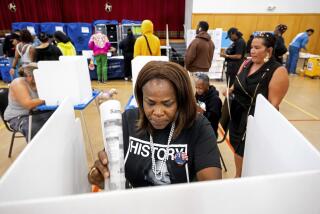Selection of pope offers a study in social choice theory
- Share via
What if we chose the pope by rock, paper, scissors?
To scholars such as Iain McLean, that’s a real mathematical and sociological question, and it isn’t as far from the choosing of a pope as you might think.
McLean, a professor of politics at Oxford, isn’t Catholic, but he’s intrigued by the choice of Cardinal Jorge Mario Bergoglio as pope. His interest in such matters is such that he once paired with a Catholic colleague, Josep Colomer, a political scientist at Barcelona University, to analyze the history of papal nomination.s “Electing Popes: Approval Balloting and Qualified-Majority Rule” is a primer of sorts on Social Choice Theory.
The Vatican’s varying methods of electing a pope over the centuries produced chaos, according to that study.
Cardinals sometimes slected a pope and “anti-pope,” leading to wars. Six cardinals died during the election of 1287. Civil authorities locked up the cardinals, furious citizens once removed the roof of the episcopal chapel, and the senator of Rome, then the top civic authority, once threatened to exhume the body of the dead pope and show him in public unless cardinals could make a decision. Eventually, though, the lockup, or conclave, fell out of favor.
Enter Peter of Morrone, an octogenarian hermit selected in 1294 after a 27-month deadlock. He became Celestine V, and before abandoning the post to go back to being a hermit, he re-instituted the conclave.
Adding a two-thirds majority in modern times brought “an optimum compromise between stability and decisiveness” to the system, McLean said.
“Two thirds forces the conclave to reject anyone who has a stong opposition in the beginning and look for a compromise, and the fact that you’re locked in leads to a compromise because you can’t take all the time in the world,” McLean said.
With a ranked-ballot system, such as the one presumed to be in use inside the College of Cardinals, mathematicians have proved that when “intermediate” candidates accrue more votes than the average of the sum of the extremes, “an unbeatable proposal exists,” according to McLean and Colomer. There’s even a formula to calculate the majority rule that would ensure such a situation.
The percentage needed for an unbeatable proposal is below two thirds - sometimes well below it, depending on the “dimensions” of the “issue space.”
McLean could identify at least three “dimensions” right away: cardinals from different countries and continents, with different social views and with different economic views.
“Instantly, you have three issue dimensions which are orthogonal to each other,” he said. That’s social-choice for being at right angles, unrelated, at cross purposes. “Once you have that set-up, you have the possibility of cycling as we say in the trade.”
Vote after vote after vote ensues with no winner, in other words.
(Imagine if rock, paper, scissors among three voters came out this way: rock, paper, scissors; paper, scissors, rock; scissors, rock, paper. If scissors backers declare their winner, paper backers can argue they beat scissors twice. Rock partisans can counter that they beat paper twice. But backers of scissors, the original winner, can argue that they beat rock twice. And on it goes ...)
A two-thirds requirement often leads to an “elimination” round, McLean said. Factions form to oppose an objectionable choice.
Bergoglio was elected by the 115 cardinals in five rounds. No one will ever know how he ranked in early rounds, but one thing is clear: “We know ex post facto there was no third that was blocking Bergoglio, because otherwise it wouldn’t be him.”
Evidence of a multi-dimensional issue space in the Vatican are clear from three elections ago, in 1978, McLean said. The College of Cardinals selected an Italian liberal, who died 33 days later, then picked a Polish conservative, Pope John Paul II. That shows “there are two rival majorities in place,” McLean said.
Pope Francis, as Bergoglio now will be known, is a classic compromise candidate, according to McLean. “He’s a different bundle of characteristics. He may be conservative doctrinally, but he’s less to the right than Benedict XVI, but at least in tax-spend terms, he’s more liberal.”
Pope Francis, McLean said, shows “some willingness to deal with the world as it is rather than the world Catholic thought would like it to be. He’s not going to commit money to battles that are already lost.”







